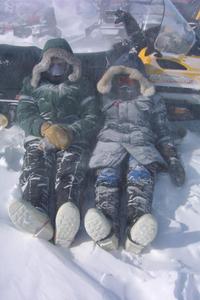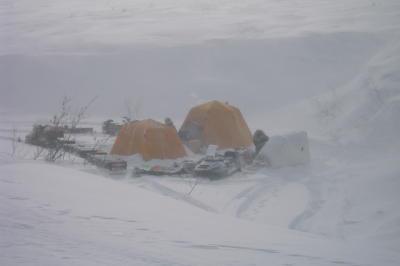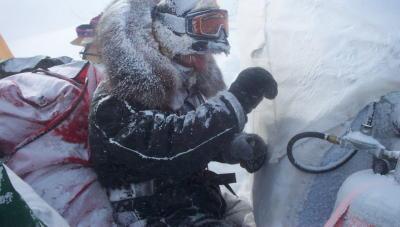18 April, 2002
Review on snow pits!!!! Many measurements and
observations are taken on the snow when a pit is dug.
The following measurements are recorded in a snow pit:
snow stratigraphy (layers), crystal size and shape,
temperature, density and hardness. We will discuss
hardness later.
At a 100-meter line, there are 5 snow pits dug. There
is one main snow pit dug at the beginning of the
100-meter line. There are also 4 quick pits dug at 25
m, 50 m, 75 m, and at 100 meters. These quick pits
are dug for an essential reason. Matthew wants an
accurate analysis of the snow from this parcticular
site. The use of the multiple snow pits allows for
accurate analysis. Since more than one snow pit is
analyzed, it ensures that a more complete picture of
the snow is recorded in that area. If only one snow
pit was analyzed, it might not be a good
representation of the area. Science often involves
taking multiple measurements. Even in the cold, for
good scientific data to be collected, there must be
multiple measurements.
WHERE IS MRS. CHEUVRONT??? LET'S PLOT!!!
LATITUDE: 69.44844 degrees North
LONGITUDE: 155.50568 degrees West
The Arctic is inhospitable. We have traveled hundreds
of miles since Ambler and there have been no signs of
human existence. There are no villages or settlements
from Ambler to Atqasuk. With the exception of some
few animal tracks, the signs of animal life have been
non-existent. In this massive space exists vast,
snow-covered land. The Arctic can be a beautiful,
enchanting, peaceful place. We have been blessed with
many of these peaceful days adorned with sunshine and
clear skies. The Arctic can also be a troublesome,
fierce, brutal place. The Arctic can turn and
have no respect for life. The winds will howl and the
cold can be brutal. It will take whatever crosses its
path. Today we experienced a brutal Arctic day.
The winds started lightly in the morning. They
gradually picked up their fierceness by mid-afternoon.
We managed to work through one complete site and two
abbreviated sites despite the winds and the cold.
However, the winds fought harder and grew fiercer. The
winds had gained enough speed
to engulf us in a ground blizzard. When the winds
reach speeds of 10 miles per hour, the snow on the
ground begins to be transported across the tundra.
Winds over this speed can create a ground blizzard.
Today there were gusts of wind up to 50 miles per
hour. The snow was being transported from the ground
up to 30 feet in the air. To us exposed out on the
snow on snowmachines, it is dangerous.
Our visibility was limited to only 25-50 feet, almost
non-existent. The winds howled and pushed us on our
snowmachines. Each person focused strongly on the
snowmachine in front. The snowmachine tracks would
disappear in a matter of 15 seconds. Matthew led us
using the GPS as his guide. He avoided cornices and
dips within the snow. The winds continued to howl.
The snow continued to blow. The winds managed to
travel through my parka and layers of clothes sending
cold chills throughout my body. If there was any
exposed skin, frostbite would occur in a matter of
seconds. It was dangerous to be out in such a
strong ground blizzard. We needed to quickly find
cover from the wind. We traveled on in a slow,
meandering line. Matthew stopped every mile to check
on the team. Finally a hiding spot away from the wind
was found. A dip, in a creek bank existed where the
snow had drifted a safe spot.
The winds continued to howl overhead but here in this
spot we were safe. The team breathed a sigh of relief.
It was late afternoon. Work was called off for the
rest of the day. Tents were erected and warm food was
consumed. Matthew quotes "The Weather always wins on
expeditions and mountaineering excursions."
One must have deep respect for the Arctic. The life
that exists here manages through harsh conditions.
Winds and bitter cold are common. The plants and
animals sustain. It is no place for humans. We
respected the Arctic storm. We found safety and sat
quietly in our tents.
Temperature min- -24 degrees Celsius
Temperature max –16 degrees Celsius

Matthew smiling as he works in the snowpit!

Ken and I are seeking protection from the wind at the beginning of the storm.

Camp, the morning after the storm. With the windchill factor, the temperature felt -65 degrees F.

Matthew repairing the SnowSTAR sled after the storm. He is sewing the fabric back onto the sled.
Contact the TEA in the field at
.
If you cannot connect through your browser, copy the
TEA's e-mail address in the "To:" line of
your favorite e-mail package.
|
